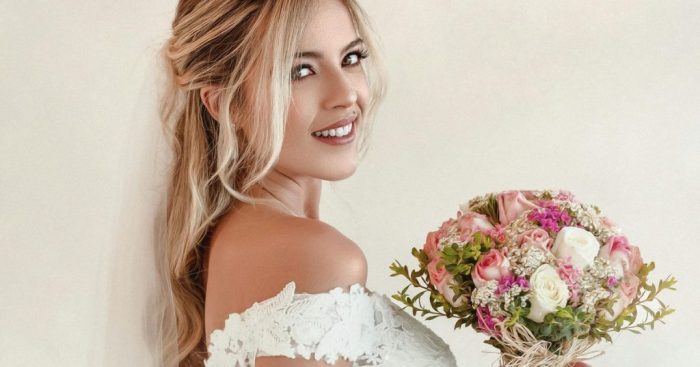Design Trends in Women’s Lace Wedding Dresses
Women’s lace wedding dresses – Lace wedding dresses remain a timeless classic, constantly evolving with shifting fashion trends. This section explores the leading design trends, comparing lace types and neckline styles, and analyzing popular silhouettes.
Current Top Three Design Trends
Three prominent trends currently shaping the lace wedding dress landscape are: the incorporation of illusion necklines and backs for a touch of modern allure; the use of intricate, geometric lace patterns for a contemporary feel; and the continued popularity of romantic, vintage-inspired lace, often paired with flowing silhouettes.
Comparison of Lace Patterns
Chantilly, Alençon, and Guipure lace each offer distinct aesthetic qualities. Chantilly lace, known for its delicate floral motifs and sheerness, lends an ethereal, romantic feel. Alençon lace, characterized by its intricate, raised patterns, creates a luxurious, sophisticated look. Guipure lace, with its thicker, more textured appearance, provides a bolder, more dramatic effect. Contemporary designs often blend these lace types, layering sheer Chantilly over structured Guipure, for example, to achieve a multi-dimensional effect.
Evolution of Neckline Styles
Over the past decade, lace wedding dress necklines have transitioned from predominantly traditional styles like sweetheart and V-necks to encompass a wider range of options. While classic necklines remain popular, we’ve seen a rise in illusion necklines, plunging necklines, and high necklines, reflecting a broader spectrum of bridal aesthetics. The modern bride is embracing more daring and unique neckline choices, often customized to flatter her individual figure.
Comparison of Popular Silhouettes
| Silhouette | Typical Lace Placement | Overall Aesthetic | Example Designer (Illustrative) |
|---|---|---|---|
| A-line | Often features lace throughout the gown, possibly with heavier lace appliqués at the bodice or skirt. | Classic, flattering, and versatile. | (Illustrative: Consider a designer known for classic A-line gowns) |
| Mermaid | Lace typically concentrates on the bodice and upper skirt, creating a dramatic, figure-hugging effect. | Glamorous, form-fitting, and sophisticated. | (Illustrative: Consider a designer known for mermaid gowns) |
| Ballgown | Lace can be used throughout, with heavier concentrations on the bodice and potentially the skirt’s overlay. | Romantic, voluminous, and princess-like. | (Illustrative: Consider a designer known for ballgown styles) |
Materials and Construction
Understanding the materials and construction techniques involved in creating a lace wedding dress is crucial for appreciating its artistry and quality. This section details the various lace fabrics, construction methods, and the process of creating a lace bodice.
Types of Lace Fabrics
Several lace fabrics are commonly used in wedding dresses, each possessing unique properties. These include cotton lace (affordable, breathable), silk lace (luxurious, drapes well), and polyester lace (durable, less expensive). The choice of fabric influences the drape, durability, and overall cost of the dress. For example, silk lace offers superior drape and a luxurious feel but comes at a higher price point than cotton or polyester.
Lace Construction Techniques
Lace wedding dresses can be created using various techniques, ranging from intricate hand-stitching to machine-made methods. Hand-stitched lace, while more time-consuming and expensive, often showcases exceptional detail and craftsmanship. Machine-made lace, while more affordable, can still achieve impressive designs through advanced technology. Many modern gowns utilize a combination of both techniques, leveraging the efficiency of machine production while incorporating hand-stitched embellishments for added detail.
Creating a Lace Bodice
Constructing a lace bodice involves several key steps, starting with pattern creation and fabric cutting. Precise measurements and careful manipulation of the delicate lace are crucial to achieve a flawless fit. Challenges may include working with the lace’s inherent flexibility and ensuring the seams are invisible and durable. The process typically involves carefully aligning and attaching the lace to a supportive underlayer, followed by meticulous finishing to ensure a clean, professional look.
Selecting Lining and Underlayment
- Assess the weight and opacity of the lace to determine the necessary level of support and coverage.
- Choose a lining fabric that complements the lace’s color and texture while offering comfort and breathability.
- Consider using a boning or corsetry structure for added shape and support, especially for intricate or delicate lace.
- Select an underlayment that provides a smooth, even surface for the lace to rest on, preventing puckering or distortion.
- Test the chosen lining and underlayment fabrics for compatibility with the lace to ensure proper blending and draping.
Styling and Accessories: Women’s Lace Wedding Dresses
The right accessories and styling choices can transform a lace wedding dress, enhancing its beauty and complementing the bride’s individual style. This section offers styling tips for various body types and explores three distinct looks.
Styling Tips for Different Body Types
A-line silhouettes flatter most body types. Brides with curvier figures might opt for lace dresses with a defined waistline and flowing skirt, while those with slimmer figures can experiment with more form-fitting styles or add volume with layers. The key is to choose a style that accentuates the bride’s best features and enhances her confidence.
Complementary Accessories
Three accessories that perfectly complement lace wedding dresses are: a delicate veil (adds a touch of romance and elegance), statement earrings (draw attention to the face and neckline), and elegant heels (complete the overall look and add height). The choice of accessories should harmonize with the dress’s overall style and the bride’s personal preference.
Three Different Looks
Look 1: Classic Romance – A traditional A-line lace gown paired with a cathedral-length veil, pearl earrings, and simple heels. Hair styled in a loose updo, makeup natural and glowing.
Look 2: Modern Chic – A sleek mermaid lace dress with a plunging neckline, paired with statement drop earrings, strappy heels, and a short, delicate veil or hair comb.
Hair styled in a sleek low bun, makeup bold and defined.
Look 3: Boho Elegance – A flowing bohemian lace gown with intricate detailing, paired with a flower crown, delicate ankle bracelets, and flat sandals. Hair styled in loose waves, makeup natural and earthy.
Visual Description of a Bride

Source: com.au
Imagine a bride in a flowing A-line lace gown, the lace a creamy ivory with subtle blush undertones. The bodice features intricate floral patterns, while the skirt cascades softly to the floor. She wears delicate pearl drop earrings, a simple diamond bracelet, and ivory satin heels. Her hair is styled in a romantic updo, accented with fresh flowers, and her makeup is natural and radiant, enhancing her natural beauty.
The overall palette is soft and elegant, emphasizing the delicate texture of the lace and the bride’s ethereal glow.
Price and Market Analysis
The cost of a lace wedding dress varies significantly based on several factors. This section explores these factors, compares price ranges, and discusses market demand.
Factors Influencing Pricing
Several factors influence the price of lace wedding dresses, including the type and quality of lace fabric, the intricacy of the design, the amount of handwork involved, the designer’s brand recognition, and the retailer’s markup. High-end designers using luxurious fabrics and intricate hand-stitching will naturally command higher prices than mass-produced gowns.
Price Range Comparison
Price ranges can vary drastically, from a few hundred dollars for mass-market dresses to tens of thousands for couture designs. High-street brands offer more affordable options, while luxury designers cater to a clientele seeking exclusive, high-quality garments. The price also reflects the brand’s reputation, the designer’s expertise, and the overall quality of materials and construction.
Market Demand
The market demand for lace wedding dresses remains strong, with consistent popularity across various styles and designs. However, trends influence the demand for specific styles, with some designs experiencing greater popularity than others in any given period. For instance, bohemian styles may be more in demand during certain years, while classic styles maintain consistent popularity.
Impact of Lace Fabric Cost
The cost of lace fabric significantly impacts the overall price of a wedding dress. High-quality, handcrafted lace, such as Alençon or Chantilly, is significantly more expensive than mass-produced lace, leading to a considerable difference in the final price of the gown. This is particularly true for dresses with extensive lace detailing or those using multiple types of lace.
Ethical and Sustainable Considerations
Increasingly, brides are prioritizing ethical and sustainable choices when selecting their wedding attire. This section discusses ethical sourcing, environmental impact, and sustainable practices within the wedding dress industry.
Ethical Sourcing of Materials, Women’s lace wedding dresses
Ethical sourcing focuses on ensuring fair labor practices and environmental responsibility throughout the production process. This includes verifying that the lace and other materials are sourced from suppliers who adhere to fair trade principles, paying workers fair wages, and employing environmentally friendly production methods. Transparency and traceability are key aspects of ethical sourcing.
Environmental Impact of Lace Production
Lace production, like many textile industries, can have an environmental impact, including water consumption, energy use, and waste generation. The use of sustainable materials, such as organic cotton or recycled fabrics, and environmentally friendly dyeing processes can significantly reduce the environmental footprint. Proper waste management and recycling initiatives are also essential.
Sustainable Practices in the Industry
Some brands in the wedding dress industry are actively adopting sustainable practices, such as using eco-friendly fabrics, minimizing waste through efficient production processes, and supporting fair trade initiatives. These brands often highlight their commitment to sustainability through transparent sourcing information and ethical production methods.
Making Ethical Choices
Consumers can make ethical choices by researching brands, looking for certifications indicating sustainable and ethical practices, and choosing dresses made from eco-friendly materials. Supporting brands committed to transparency and fair labor practices helps promote a more ethical and sustainable wedding industry. Considering the longevity and potential for repurposing the dress also contributes to reducing environmental impact.
Expert Answers
How do I care for my lace wedding dress after the wedding?
Professional cleaning is highly recommended. Follow the dry cleaner’s instructions carefully for long-term preservation.
What is the best time of year to wear a lace wedding dress?
Lace dresses are versatile. Lighter laces work well in warmer months, while heavier laces are suitable for cooler seasons.
Can I alter a lace wedding dress?
Yes, but it’s best to consult a professional seamstress experienced with delicate lace fabrics. Significant alterations may be challenging.
Women’s lace wedding dresses offer a timeless elegance, often incorporating intricate patterns and delicate details. The choice of fabric and design can significantly impact the overall look, and many brides opt for a classic silhouette. For those seeking a pristine and sophisticated aesthetic, exploring options like a women white wedding dress is a popular choice. Ultimately, the perfect lace wedding dress depends on personal preference and style, offering a range of possibilities from romantic to modern.
Are there different levels of quality in lace?
Absolutely. Lace quality varies greatly depending on the materials, construction techniques (handmade vs. machine-made), and the intricacy of the pattern. Higher quality lace generally translates to higher durability and cost.

